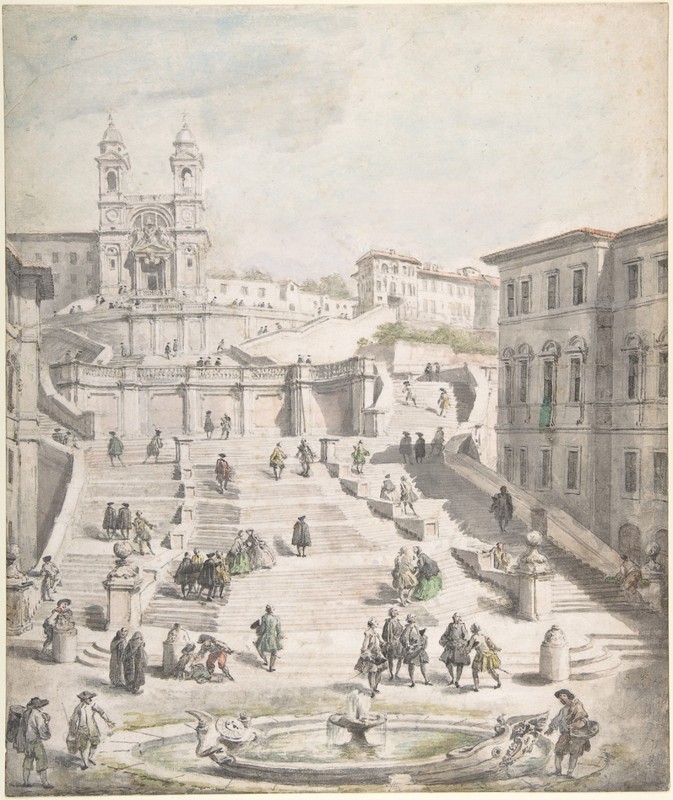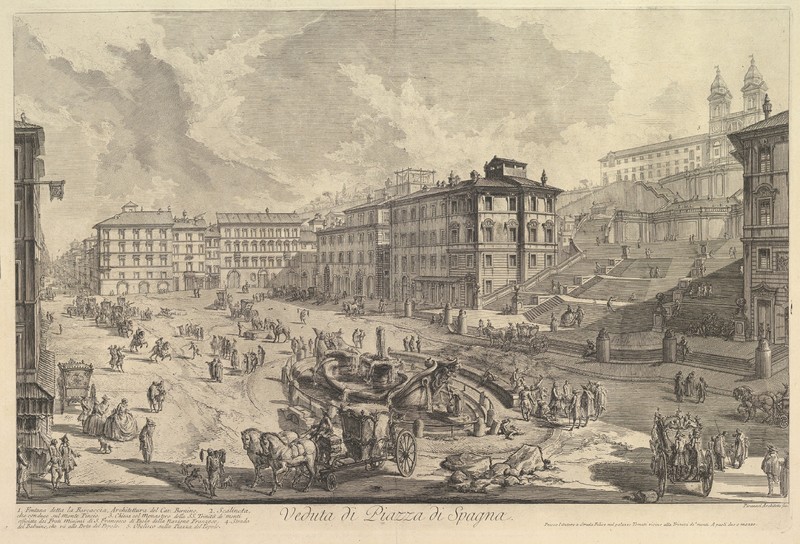Panini and Piranesi

Giovanni Paolo Panini, Scalinata della Trinità dei Monti, c.1756-58, Pen and black ink, brush and gray wash, watercolor, over graphite (Metropolitan Museum of Art)
Panini also completed some smaller works in watercolor, which later factored into his large scale “Modern Rome” paintings, and further our appreciation of Panini’s ability to capture the sense of these sites as lively and integral to the drama of life in the city at the time. The Scalinata della Trinità dei Monti from 1756-58, is a mixed-medium watercolor, currently in the Metropolitan Museum’s collection in New York City. The work features what is commonly known as the Spanish Steps. Panini employs light, faded hues of pink, green, and grey in a scene filled with architectural details. As art historian Linda Boyer Gillies notes, the work “also provides a spontaneous glimpse of Roman life”; as in his paintings Panini utilizes the figures in the composition to give a sense of the dynamism of the place.[1] The Scalinata depicts figures ascending the steps, as well as engaging in every day life in the piazza. The composition culminates at the top of the stairs with the main church, the Trinità dei Monti, and surrounding it on both sides, lower buildings constructed by the French in the eighteenth century.[2] Interestingly, although the watercolor is thought by the Metropolitan Museum to be a stand-alone work, and not a study for a larger composition, a painted version of the landmark appears in the multiple versions of Modern Rome. The renditions in the painting, while in characteristic Panini style remain impeccably faithful to the architecture of the place, are strikingly similar to the watercolor. Thus, with his seemingly stock reuse of places and images, Panini shows that he is not above the “post-card” trend that was prevalent during the height of the Grand Tour. Yet this too played to the culture of the Grand Tour, these stock scenes and images creating a type of iconography that in turn further endowed a location with the reputation for being a recognizable landmark, crucial to the tourist’s journey through Italy.

Giovanni Battista Piranesi, "The Piazza di Spagna (Veduta di Piazza di Spagna)" from Vedute di Roma, c. 1750, etching (Metropolitan Museum of Art)
One of Rome’s most prominent vedutisti, Giovanni Battista Piranesi, made his own renditions of Piazza di Spagna, though in the medium of etchings. A study of Piranesi’s approach to the setting accentuates the artistic differences between Piranesi and Panini. Piranesi’s Piazza di Spagna etching is part of the series Vedute di Roma, and was completed circa 1750. Piranesi’s composition sets up the landscape very differently from Panini; instead of capturing the view from the feet of the Spanish Steps, Piranesi creates a wider view which encapsulates the entirety of the Piazza.[3] On the right hand side, the viewer is nonetheless able to see the Scalinata della Trinità dei Monti, though from an angle. The fountain at the center of the piazza and the surrounding buildings occupy the majority of the composition. Surrounding the fountain, clusters of people simply passing through the piazza give a sense of reality to the scene. The viewer could imagine the work as a snap shot of a moment frozen in time. Indeed, even more so than Panini, Piranesi’s etching presages the post card photograph, and serves a similar purpose, providing the viewer with an objectified rendering of the place. While like Panini, Piranesi does use figures engaging in daily life, the etching lacks the charm and liveliness so present in the Scalinata. The difference in medium—one is a watercolor and the other is an etching—accounts for some of this. That being said, watercolor in itself does not account for the delicate and ephemeral quality of the Scalinata and the sensation of Rome’s endless charm and liveliness that permeates the composition. Piranesi’s Rome is a colder, sharper and more aggressively defined place, a style that served him well in producing prints as “post-cards”, mass produced memento’s and souvenirs for incoming Grand tourists. Although Piranesi presents figures in the composition to denote dynamism, the viewer is instead entranced by the angular lines; the figures seem somehow extraneous. Panini’s hints of pink and green, and the warm glow of light illuminating the composition by contrast communicate a sensory impression of the Piazza di Spagna as a tourist would experience it upon visiting.
JB
[1] Linda Boyer Gillies, “An Eighteenth-Century Roman View Panini’s Scalinata Della Trinità Dei Monti,” The Metropolitan Museum of Art Bullein 30, no. 4 (1972): 176.
[2] Ibid., 184.
[3] Mario Bevilacqua and Fabio Barry, The Rome of Piranesi: The Eighteenth-Century City in The Great Vedute (Rome: Artemide, 2006), 67–68.